- Details
- Written by Gordon Prentice
Town Hall officials last week confirmed that the Monster Home nearing completion at 1011 Elgin Street meets the Town's zoning standards. This has been a matter of some debate since March of last year. 
Back then, the Director of Planning, Rick Nethery, told me:
"Essentially the proposal (for the new building at 1011 Elgin Street) only required a routine building permit issuance as it complies with the relevant zoning requirements in respect of height, setbacks and lot coverage."
Because only a building permit was required there was no public consultation with neighbours nor with anyone else.
Construction blues
Round-the-clock building work has been going on since the summer of 2016. Some days, furious activity. On other days, less. It started with the excavation of a huge hole in the ground to accommodate the garage which sits under the house. The structure, still unfinished, towers over the neighbouring property whose deck and garden, previously secluded and private, are now overlooked. 
All proposed developments in Newmarket are subject to Council approval through the approval of site plans. But some categories of development escape scrutiny.
Councillors were never asked to take a view on this over-sized cuckoo in the nest in Elgin Street as it fell into an exempt category which would simply be waived through by the professional bureaucracy.
Residential structures on existing lots:
"such as a detached dwelling, semi-detached dwelling, or duplex if the application does not involve a change to a more sensitive land use"
are exempt from site plan control. All the developer needs is a building permit.
Site Plan Manual
Tomorrow (Monday 15 January 2018) Councillors will be asked to review and then give their seal of approval to a revised Site Plan Manual whose stated aim is to speed up the approvals process.
This is a noble intention. Getting approval can take forever while all sorts of outside agencies are consulted. Anything to inject a sense of urgency into things is to be applauded.
Unfortunately, the Manual still doesn't address the Elgin Street issue. The Town should have had the debate on residential infill and whether any site plan control should be applied and in what circumstances rather than the other way about. Cart before the horse and all that.
We've all known for ages that some infill development in residential areas simply doesn't fit in. Indeed, Newmarket's planners presented a report to councillors in 2012 identifying the issues and posing possible solutions. In the intervening five years we have witnessed paralysing inactivity. Indeed a report presented to councillors in October last year on the issue regurgitated much of what was said in the earlier document.
Workshop this month
During the short debate on Infill in Stable Residential Areas last October the Director of Planning, Rick Nethery, held out the possibility of a Council workshop this month. The public would then be consulted in March or April with any new policy being in place by June
"subject to any appeals that could arise".
Personally, I think that timetable was always for the birds. It seemed too good to be true.
In the meantime, what is unfolding at 1011 Elgin Street could happen over and over again. Older neighbourhoods with houses sitting on bigger than average lots are routinely targeted by smart developers with an eye to the main chance.
Ward 3 councillor, Jane Twinney, concerned about what was happening in her patch, asked for a review of policy on infill development a full ten months ago and we are still waiting.
Hibernation
This is election year when municipal bureaucracies everywhere go into hibernation, leaving difficult policies for the new Council to address. But, surely, the time for slumbering is over.
With every passing moment, Morad Dadgar moves ever closer to completing his huge Monster Home which we are assured complies with the relevant Zoning By-law.
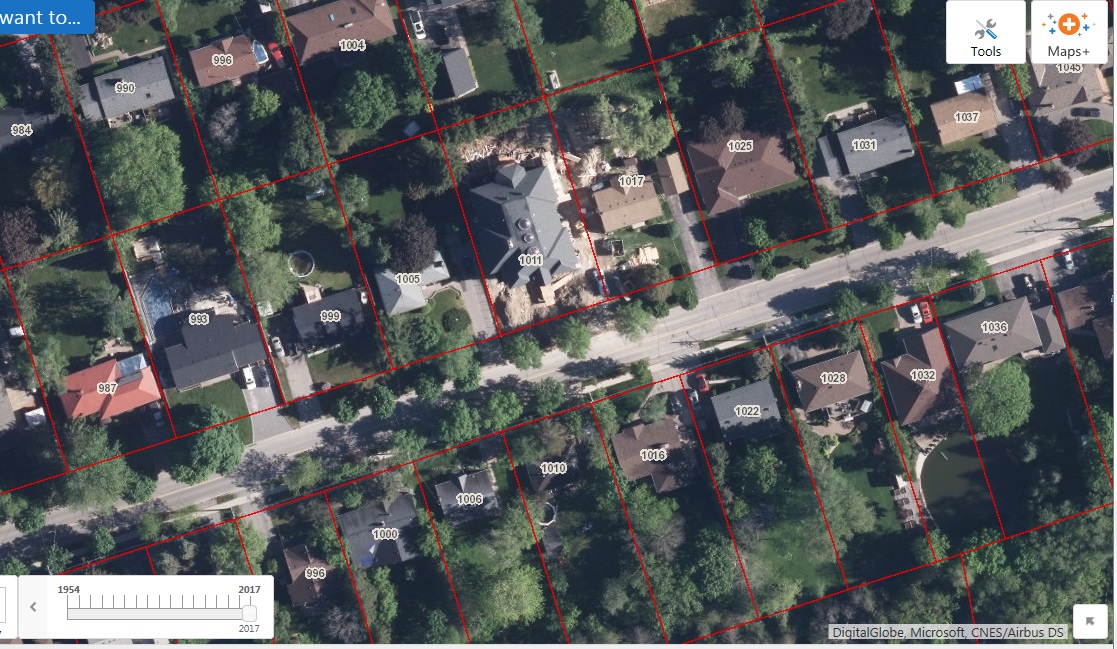
In March 2017, the Director of Planning told me the site plan showed a generous front yard set-back of 9.88 metres when the Zoning By-law stipulated a 7.5 metre minimum. Now the latest figures tell me the front yard set-back has mysteriously increased to 11.44 metres.
The by-law sets a maximum permitted lot coverage of 35%.
In March 2017, this was 31.33%
Now, curiously, it has crept up to 33.6%.
I have no idea how this happened.
But we are told conclusively that 1011 Elgin Street complies with the Town's zoning standards and that, as I lamented last year, is precisely what is so worrying.
This email address is being protected from spambots. You need JavaScript enabled to view it.
Read the report on the proposed revised Site Plan Manual here at page 32.
Update on 15 January 2018: The Town’s Director of Planning, Rick Nethery, told councillors today that the planned Council workshop on infill development in stable residential areas would be held in March 2018.
- Details
- Written by Gordon Prentice
Should we feel sorry for developers who are asked to make "voluntary contributions" to the Town to help pay for such things as trails, community entrance signs and public art? 
These so-called "voluntary contributions" can cost a developer many thousands of dollars. In 2014, at the start of this Council term, the Town collected $628,300 in voluntary trail contributions from developers. This is big money.
But what if the developer says no? Do they have an option? Is it a shakedown? Is it legal?
Perhaps these "voluntary contributions" are written off by developers as a necessary cost of doing business in Newmarket. Who knows?
Extortion
A couple of weeks ago an email comes winging in from cyberspace, complaining about the Town extorting money from developers. Attached to that email was another, dated 28 November 2017, from the Town's Chief Administrative Officer, Bob Shelton, directed specifically at developers:
"I wanted to discuss Community Benefit contributions with you.
"Newmarket has been moving forward with significant investment in the community well beyond what can be supported by the tax base and other sources of funding. These investment [sic] include accelerated trail development, community entrance signs, and unique public art features. These Community Benefit investments greatly contribute to Newmarket's growing reputation as a place to live, work and visit. They assist in the attraction and retention of investors, business, employees and residents."
"We have been able to make these additional investment [sic] into our community creating a sought after quality of life through generous contributions made by citizens, businesses, organisations and land developers. This has been viewed as a win-win as these community benefit amenities assist in such areas as marketing products and maximising value."
"The Community has benefitted from contributions towards these investment [sic] by way of lump sum contributions to contributions in the $1,600 to $2,500 range on a per unit basis depending on the unit size. The Town would be able to offer a charitable donation receipt or recognition to your company for this voluntary contribution to be used by the Town for Community Benefit projects."
"Based on your recent advice to the Town it would appear that you are moving forward with your proposed development. Could you please consider assisting the Town with this program and advise me of your intentions in this regard. I will also try to reach out to you to discuss our program later this week."
No sewage hook-up means no development
The day before (27 November 2017) councillors had a report before them on so-called "servicing allocations". Until a development - even one with planning approval - gets permission to hook up water and sewage pipes it cannot proceed.
In Newmarket, because of capacity constraints arising from the delay in completing the Upper York Sewage Solutions project (which comes on stream in 2024) these servicing allocations have to be rationed. Developments are listed by priority.
Three proposed developments (King George, Eagle and Gorham) are down as priority 4 but are fast tracked after votes moved by Tom Hempen and Dave Kerwin. As a result, these developments can now be hooked up, leapfrogging over others.
After the vote Bob Corleone’s letter goes out to developers asking for cash. Dare they say no?
In 2015, Steve Deveaux, the Chair of BILD (Building Industry and Land Development Association) tells MPPs during the Committee stage of the Smart Growth for our Communities Act (Bill 73):
"We found that some municipalities successfully levied additional charges on the industry for a variety of proposed projects with questionable public policy merit. This resulting voluntary agreement is only agreed to because there is no other way of getting approvals, permits or servicing to the project."
It takes two to Tango say the developers
BILD has been pressing the issue for years. In 2014 they tell the Province:
"For a contribution to be voluntary it must have two willing parties. It is usually the case that the party paying these charges is not willing. Rather, the payment is often made because it would take too long to appeal it to the courts or the OMB and it also creates a difficult working relationship in communities where there will be ongoing future relationships."
Shelton assures me there is no funny business:
"For development related discussions, my approach is to confine these discussions to the CAO's office (Chief Administrative Officer) which takes place outside of and after the development is in a position to move forward..."
Even so, the Bill is supposed to get rid of these "voluntary agreements".
No additional levies
59.1 (1) A municipality shall not impose, directly or indirectly, a charge related to a development or a requirement to construct a service related to development, except as permitted by this Act or another Act.
The Bill 73 Committee hears from a number of municipalities who say these "voluntary payments" are a good thing and should not be outlawed. MPPs are told they are needed to bridge the gap between what comes in through development charges and the actual costs of growth.
Indeed, I recall Bill Hughes, the widely respected Director of Finance at York Region, telling us that growth does not pay for growth. That has always been the monumental fiction. 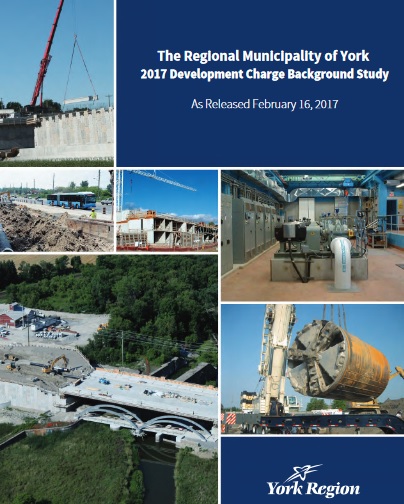
In fact, the Municipal Finance Officers of Ontario, quoting research by others, tell the Bill Committee:
"Development Charges now only pay for approximately 80% of growth related costs. That puts significant pressure on municipalities, which are faced with huge infrastructure deficits as well as demands for new services, and trying to rehabilitate and maintain existing infrastructure."
Despite pressure from the Association of Municipalities of Ontario and from some of their member authorities urging the Government to look again at s59.1, Ministers hold fast and the section now appears in the Development Charges Act 1997, as amended.
Law of the land
It is now the law of the land. But what does it really mean?
In York Region's 352 page tome on the 2017 Development Charge Background Study, published in February this year, we are told the Act prohibits voluntary payments:
"The amendments to the Development Charges Act 1997 prohibit the imposition of additional levies, commonly understood to mean voluntary payments or extra-legal agreements, related to a development. Staff are investigating the definition of voluntary payment agreements to ensure the Region remains compliant in the future. Existing voluntary payments are grandfathered."
I don't know if the detectives in York Region's finance department have now unearthed the definition on which so much now turns.
Treasurers to certify compliance
Despite this opacity, Municipal Treasurers across the Province are now doing their best to certify that their Reserve Funds are now in compliance with s59.1 - even if they are not entirely sure. In the City of Vaughan we learn:
"The City has, to the best of its knowledge, not imposed any voluntary payments or required construction of a service not authorised under the Act." (The Development Charges Act 1997, as amended.)
I am left wondering how "voluntary" payments can be imposed? I go through life relying on ordinary English usage but once the lawyers start mangling the language we can all get lost.
Markham worries that the prohibition of voluntary contributions might impact on
the receipt of funds for public art and public realm.
This is what Shelton wants the money for - among other things.
Closing the door on "voluntary" payments
Councillors across the Province are now being told, in variations on the same theme, that s59.1 is intended to close the door on "voluntary" payments that may have been sought by municipalities "outside the legislative framework".
So, in Newmarket, are the voluntary contributions sought by Bob Corleone "outside the legislative framework" or not?
Is it OK to lean on developers for cash to fund "public art"?
The Town has been upfront in asking for cash for years, even to the extent of telling developers (in 2015) what the Town's "base expectations" are for voluntary contributions for trail, public art and community projects.
Everything is kosher
I look for a statement from Newmarket's resourceful and inventive Treasurer, Mike Mayes, certifying everything is kosher but I can't see it.
That's not to say it doesn't exist. It could be staring me in the face.
Bob Corleone is now inviting me to meet the Treasurer if I need more information to help me understand the process.
He is making an offer I can't refuse.
This email address is being protected from spambots. You need JavaScript enabled to view it.
- Details
- Written by Gordon Prentice
On 20 March 2017 Newmarket councillors reaffirmed their existing policy of getting their remuneration paid one-third tax free. 
They rationalised. They justified. They agonised. But, at the end of the day, after all the hand-wringing, they voted to keep their special tax free status.
Now, cruelly, the Federal Government has decided to take away this generous concession as from 2019. The move was buried in the 2017 Federal Budget and applies nation-wide. It was under-reported.
The Association of Municipalities of Ontario in a news release earlier this month was still peddling the myth that:
"Municipal elected officials across the country have been able to decide to use a 1/3 tax exemption in lieu of claiming expenses related to their duties."
That may be true in some saintly municipalities tucked away, out of sight, in remote corners of Canada. But it isn't true here in Newmarket where our Mayor, Tony Van Trappist, claims for every butter tart consumed at the Maid's Cottage.
Removing tax-free status is long overdue and should be welcomed by all elected officials.
The current system makes it virtually impossible to compare the remuneration of elected officials in different municipalities - especially with those that have ditched their tax free status.
This complexity suits the Van Trappists of this world. The old banker kept his Hydro remuneration off the Town's accounts for years until I forced the issue and his additional $12,000 a year is now routinely reported. This kind of subterfuge cheats the voters.
We need good elected officials to take important decisions on our behalf, often shaping our Town for decades to come.
They deserve the rate for the job.
So long as it doesn't include tax free status.
This email address is being protected from spambots. You need JavaScript enabled to view it.
- Details
- Written by Gordon Prentice
The Clock Tower Hearing at the Superior Court in Newmarket, due to come up tomorrow, Wednesday 15 November 2017, at 11am, is off. It has now been rescheduled - for the fourth time - to 14 May 2018. 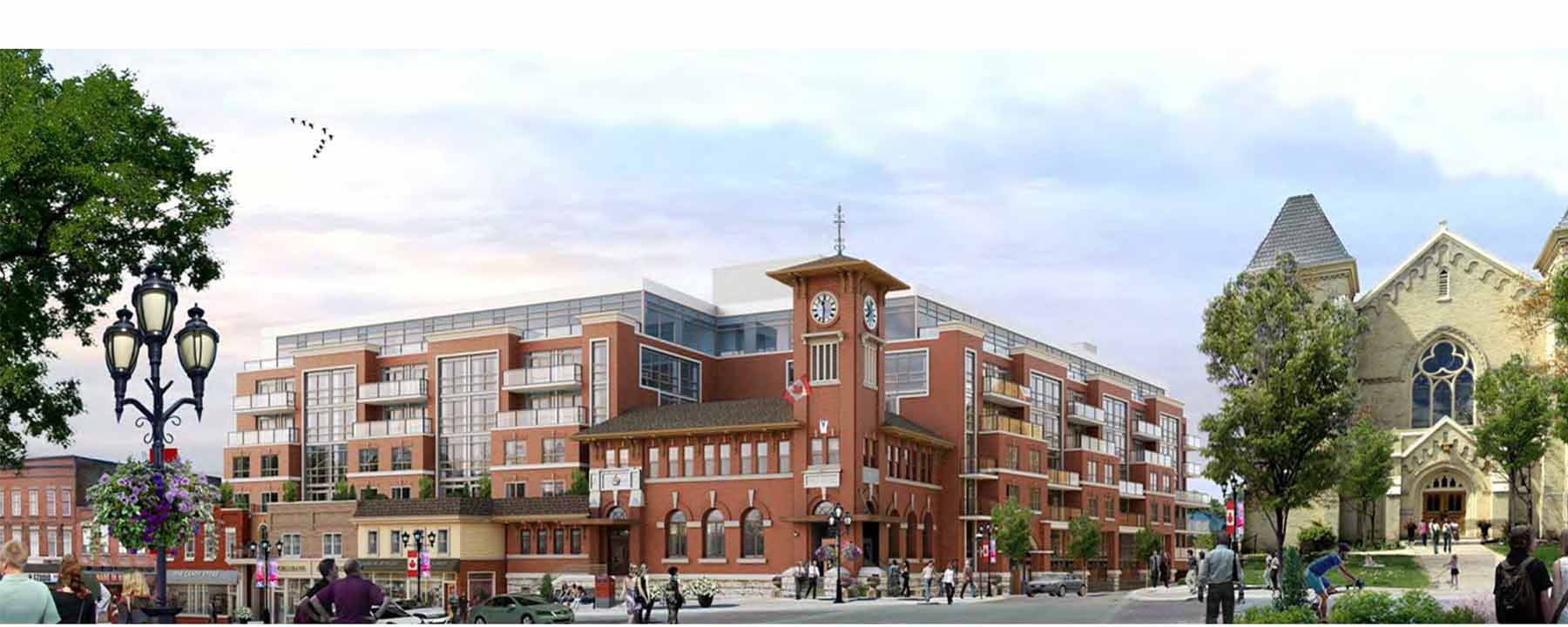
On 3 November 2017, the Town's counsel, Leo Longo of Bay Street lawyers Aird and Berlis LLP, requested a postponement for reasons which are still unclear to me. Papers were originally filed with the Court on 14 June 2017.
The Town wanted a declaration from the Superior Court that a land swap agreement it entered into in 2003 with the then Main Street property owner, Michael Bryan, is binding on Bryan's successor in title, Bob Forrest's Main Street Clock Inc.
Spanner in the works
If the Town succeeds it throws a spanner in the works leaving Bob with a development, as currently drawn, that is impossible to build.
It still puzzles me why the Town's counsel didn't ask the OMB to throw out the Forrest application without a hearing.
But that's yesterday's story. Today I want to know why the Town sought to postpone, yet again, the hearing of the application.
We know that Leo Longo was in discussions with Bob's counsel, Ira Kagan, about getting a suitable date that would work for both of them. On 7 July 2017 Longo emailed Kagan to confirm that
"...due to counsel availability, the return date for the hearing of this matter (Corporation of the Town of Newmarket v Main Street Clock inc) has been moved from October 20, 2017 to November 15, 2017 at 9.30am. The time allotted for the hearing of this matter is three hours."
The new date of 14 May 2018 is perilously close to the new start date of the OMB Clock Tower Hearing, set for 7 August 2018. If the Court hearing goes ahead on 14 May the Judge will hear legal argument and then deliver his or her ruling, perhaps a month or two later.
Army of people
In the meantime and at great expense, a small army of people will be preparing for the OMB hearing on the Clock Tower which will be critically influenced, one way or the other, by the Judge's ruling on who owns the land in Market Square.
This glacial timetable works for the lawyers but what about the public interest?
What about the boarded up and decaying heritage buildings in Main Street?
What about the traders and business people who depend upon a lively and busy downtown?
We are all being failed by a creaking system, not fit-for-purpose, where massive delays are par for the course.
We shouldn't accept this with a shrug of the shoulders as being inevitable.
I don't.
This email address is being protected from spambots. You need JavaScript enabled to view it.
Update 16 November 2017: I asked Esther Armchuk, Newmarket's former Town Solicitor and now Commissioner of Corporate Services, why the Town had sought a postponement. She helpfully told me yesterday:
"The hearing, originally scheduled for today, was adjourned on consent of the lawyers for both parties. Additional time is required to complete the exchange of evidentiary documents, schedule cross examinations on affidavits and argue the matter before Court. The Court had only scheduled 3 hours today for the hearing of this matter, and both parties require more time.
The Newmarket Superior Court has scheduled the matter to be held during the three week long motion/trial session that commences May 14, 2018. At some point during that three week period, the lawyers for the Town and for Main Street Clock Inc. will be given notice by the Superior Court trial office to attend the following day to argue the matter. When that occurs, we will post the hearing date information to the Town's website for the Clock Tower matter. Staff will advise Members of Council and update the website as soon as the new date for this matter has been set."
I am grateful for the explanation but it still doesn't satisfy. Members of the public can expect 24 hours notice of when Newmarket v Main Street Inc is going to come up before a real, live Judge. And why is the whole thing taking so long? Why couldn't the lawyers have sorted out the exchange of evidentiary documents and schedule cross examinations on affidavits by now? They've had months already. I hate to think what the bill will be like when Leo Longo eventually presents it to the Town.
- Details
- Written by Gordon Prentice
The Redwood on Yonge development (on the old Slessor Square site at 17645 Yonge Street) sailed through its Statutory public meeting last week (6 November 2017) without a single comment from local residents. 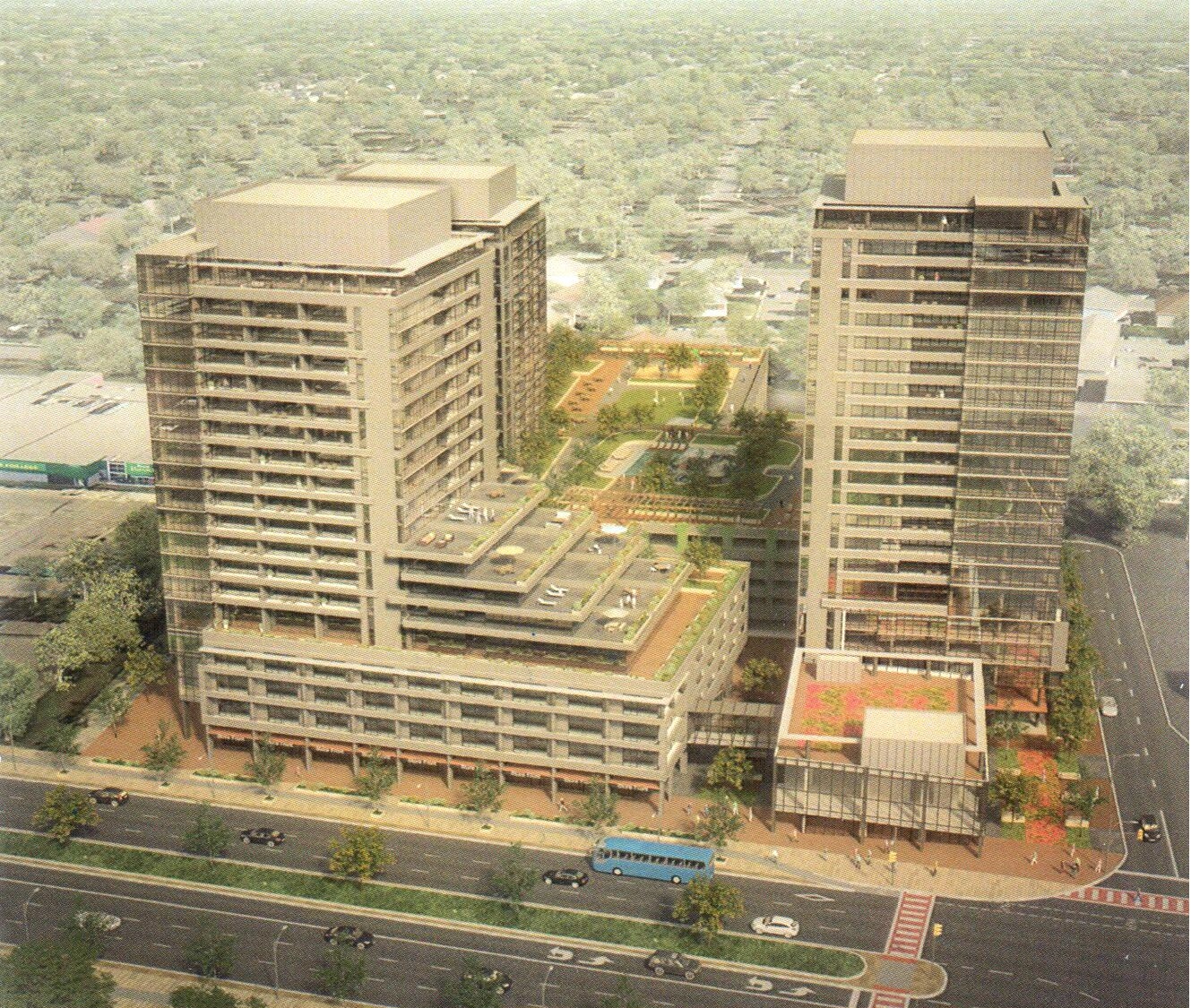
Does this mean everyone is deliriously happy with it? Probably not.
This major development will have 527 rental apartments in three residential towers, to be built sequentially in three phases over, perhaps, ten years. There are no plans for any of the apartments to be marketed as "affordable" using the affordability figure published annually by York Region. In 2016 it stood at $1,496 per month.
The Town's Secondary Plan reflects regional policy by stipulating that a minimum of 35% of new housing units in the Urban Centre (which includes 17645 Yonge Street) shall be affordable to low and moderate income households.
The report from the planning staff says:
"This 35% is not intended to be achieved on each individual application but rather within the Provincial Urban Growth Centre as a whole."
This is a good example of the planners kicking the can down the road, leaving it to another day, rather than confronting the issue now.
Conversations about affordability
Jane Twinney is the first councillor to ask about affordable housing. Is that part of the development? The Director of Planning, Rick Nethery, predictably reminds everyone that the 35% doesn't apply to individual developments.
"We have been having general conversations with the applicant. It is worth noting that the Secondary Plan speaks to a 35% affordable housing target - not for specific properties but for the whole Provincial Urban Growth Centre. So far, based on the information we have received from the applicant, there hasn't been an awful lot that speaks directly to that but we have the opportunity to have the conversation and whether or not there is any additional information they might be able to share with that. I don't know if Brad has anything to say."
This allows the developer's planning consultant, Brad Rogers, the man who is absolutely everywhere, to remind us the development will take ten years to complete.
So what? Does it have an affordable housing component or not?
Brad says he is happy to have conversations. He tells Twinney:
"It is about a ten year build out for all three phases so it will take at least two years to build the first building and so this transition of the property, it is not going to happen overnight. It is going to take a lot of time."
"And with respect to affordability and the rental component at this point we don't know what the rental rates are but we are happy to have these conversations with the Region of York and these types with respect to affordability."
Now Taylor wants to get into the conversation too:
"A development of this magnitude, if it doesn't help address the affordable housing issue in part then it puts quite a burden on some of the smaller developments that will subsequently come. So I hope this is a conversation we can continue to have and look at it."
Housing crisis
When they all get round to having their conversations I hope they will address a simple point that is staring everyone in the face. There is a housing crisis in Newmarket and across York Region. Put simply, spiralling house prices have put home ownership beyond the reach of too many people. And rents are way too high for too many people.
The Region polices the policy on affordability via annual reports showing progress against targets in the Region's 10-year Housing Plan. Here is the 2016 progress report on housing plan debated in June 2017
The Provincial Government says it is addressing the twin issues of getting housing to market faster and ensuring it is affordable. 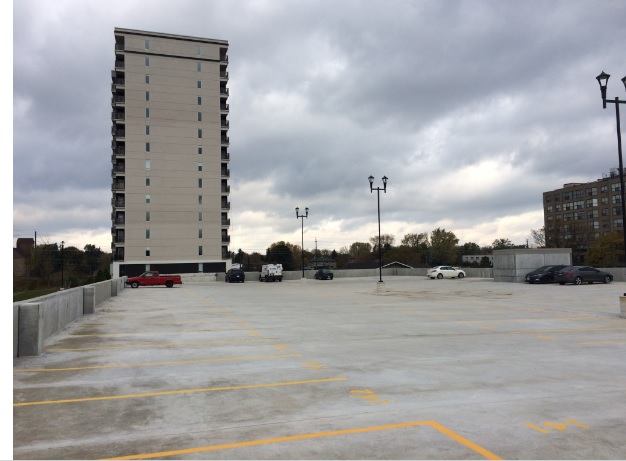
Here in Newmarket, 212 Davis Drive is being held up as a signature achievement in getting more rental accommodation actually built and occupied. Of course, to get this far, the Town had to make concessions to tempt the developer to go down the rental route but this is the world we live in.
Development charges were deferred and the Town allowed a huge slab of surface parking at 212 Davis Drive (see right) when its own Official Plan makes it clear:
"Parking areas should be located underground wherever possible in the Urban Centres."
Clearly, "wherever possible" is sufficiently elastic to allow surface parking if there are other competing policy imperatives. The huge Deerfield development next door to 212 Davis Drive and (beneficially) owned by the same Rose Corporation will be asking the Town in due course to give permission for a three storey above ground parking garage in the first phase, integrated into a four storey podium. Sounds a bit like Redwood.
In any event, surface parking, as the Rose Corporation's Sam Reisman will tell you, makes developments cheaper to build.
Inclusionary Zoning
In future, the Town may get round to triggering the powers municipalities have been given to force developers to include affordable housing in their developments through inclusionary zoning.
But for many people, including professional planners whose close symbiotic relationship with developers is a simple fact of life, that may be a step too far.
This email address is being protected from spambots. You need JavaScript enabled to view it.
Page 144 of 269